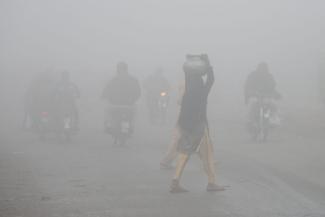Environmental protection
Cleaner air for Punjab

Air pollution is a serious health hazard in Pakistan. In 2014, the World Bank reckoned that it causes an annual 20,000 premature deaths of adult persons. Moreover, millions of children were said to suffer illnesses because of air pollution. Things have probably gotten worse since then, since hardly any steps were taken to improve air quality.
Thick layers of smog do not only cause low visibility, but also respiratory diseases, eye infections and allergies. Things are especially bad in autumn and winter. In 2020/21, that coincided with an alarming surge in Covid-19 infections. The novel coronavirus too attacks the respiratory system.
The provincial government of Punjab has decided to take action. About half of Pakistan’s 220 million people live in this province. The hope is to reduce air pollution in the agriculture sector.
A burning problem
Farmers traditionally burn paddy crop residues after the harvest in October and November. This ancient practice allows them to get rid of the waste in order to prepare soil for the next planting season. This needs to be done fast because many farmers grow rice in the rainy season and then wheat immediately in the following weeks. They have to hurry to make best use of the time before winter makes agriculture impossible. Other advantages of burning crop residues include that it does not require much work, but serves to fight weeds and pests. These are things the UN Food and Agriculture Organization (FAO) reported in a study of air pollution in Punjab in 2019.
Burning crop residues causes smog however, and the situation has been getting worse for years. The provincial government wants farmers to take a new approach and is giving them financial incentives. Two machines are needed, and farmers who buy them will only have to pay 20 % of the price, with the government bearing the other 80 %.
The first machine is called rice-straw shredder. It allows farmers to break the rice stubble and mulch it in the ground and plough it into the fields as organic fertiliser. The second machine is called happy seeder. Its purpose is to sow wheat seed fast after the rice harvest. Over two years, the Punjab government expects to spend the equivalent of $ 2 million on these machines in support of farmers in 15 major rice-growing districts.
The approach makes sense. One of its strong points is that the machines are locally developed. The new policy is certainly a step in the right direction.
However, other major sources of air pollution remain unchecked. According to the FAO, transport accounts for 43 % of air pollution in Punjab, and industries for 25 %. Agriculture only comes third with 20 %, while coal-fired power plants (12 %) are the fourth most important emitters.
Not only Punjab, but the entire country still lacks a comprehensive and well-coordinated strategy to improve air quality. The depressing truth is that some relevant laws exist, but are not enforced. The government is supposed to issue fitness certificates to public and private vehicles to keep their emissions to a minimum. No effective mechanism exists for doing so. Nor is there a policy to promote public-transport services in order to bring down the number of motorbikes, cars and trucks: a new electric-vehicles policy was adopted in June, but it does not amount to a serious effort to replace Pakistan’s masses of old, rickety and heavily polluting vehicles. All the while, the burning of municipal waste continues, and industries keep spilling out thick black smoke.
We will see next year what difference the farm-machine subsidies will make in Punjab. We also know that more needs to be done, no matter how successful it turns out to be.
Reference
FAO, 2019: Smog in Punjab.
http://www.fao.org/3/ca6989en/CA6989EN.pdf
Imran Mukhtar is a journalist based in Islamabad.
imranmukhtar@live.com
Twitter: @imranmukhtar








